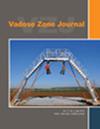Microbial mediated carbon and nitrogen cycling in the spatially heterogeneous vadose zone: A modeling study
IF 2.8
3区 地球科学
Q3 ENVIRONMENTAL SCIENCES
引用次数: 0
Abstract
Spatially distributed properties of the subsurface result in varying water saturation and preferential flow paths, which lead to heterogeneous solute transport patterns and heterogeneous microbial environments. This, in turn, influences the distribution of nutrients and energy gradients, microbial biomass, and activity thereof. By their very nature, current field sampling techniques do not resolve subsampling scale heterogeneities in microbial biomass and activity, resulting in inaccurate estimates of microbially mediated carbon and nitrogen turnover in the heterogeneous subsurface. Thus, in this study, we undertook a numerical modeling approach to study the impact of spatial heterogeneity on microbially mediated carbon and nitrogen turnover in the vadose zone. We adapted an established biogeochemical process network that captures a variety of respiration pathways, carbon decomposition strategies, and microbial life processes to simulate microbially mediated carbon and nitrogen turnover in variably saturated spatially heterogeneous settings, using an established numerical tool (OGS#BRNS). The fractionation of microbial communities into active and inactive states, as well as immobile and mobile states followed could be linked to the bulk average saturation. Lastly, we identified three reactive systems, distinguished by the rate ratio of aerobic respiration and transfer of oxygen from the air to the water phase, to evaluate the impact of spatial heterogeneity on carbon and nitrogen removal in subsurface heterogeneous domains. Specifically, when this ratio is approximately 1, there is no impact on carbon removal, while when this ratio is very high, then carbon removal decreases as the domain tends to be oxygen limited.以微生物为媒介的空间异质渗流带碳氮循环:模型研究
地下水的空间分布特性导致不同的水饱和度和优先流动路径,从而形成异质溶质迁移模式和异质微生物环境。这反过来又会影响养分和能量梯度的分布、微生物生物量及其活性。就其本质而言,目前的实地取样技术无法解决微生物生物量和活性的子取样尺度异质性问题,从而导致对异质地下微生物介导的碳和氮周转的估计不准确。因此,在本研究中,我们采用数值建模方法来研究空间异质性对含水层中微生物介导的碳氮周转的影响。我们调整了一个已建立的生物地球化学过程网络,该网络捕捉了各种呼吸途径、碳分解策略和微生物生命过程,利用一个已建立的数值工具(OGS#BRNS)模拟了在可变饱和的空间异质性环境中微生物介导的碳氮周转。微生物群落分为活跃和不活跃两种状态,以及不移动和移动两种状态,这与总体平均饱和度有关。最后,我们根据有氧呼吸和氧气从空气转移到水相的速率比确定了三种反应系统,以评估空间异质性对地下异质域碳氮去除的影响。具体来说,当这一比率约为 1 时,对碳的去除没有影响,而当这一比率非常高时,碳的去除就会减少,因为该领域趋向于氧气有限。
本文章由计算机程序翻译,如有差异,请以英文原文为准。
求助全文
约1分钟内获得全文
求助全文
来源期刊

Vadose Zone Journal
环境科学-环境科学
CiteScore
5.60
自引率
7.10%
发文量
61
审稿时长
3.8 months
期刊介绍:
Vadose Zone Journal is a unique publication outlet for interdisciplinary research and assessment of the vadose zone, the portion of the Critical Zone that comprises the Earth’s critical living surface down to groundwater. It is a peer-reviewed, international journal publishing reviews, original research, and special sections across a wide range of disciplines. Vadose Zone Journal reports fundamental and applied research from disciplinary and multidisciplinary investigations, including assessment and policy analyses, of the mostly unsaturated zone between the soil surface and the groundwater table. The goal is to disseminate information to facilitate science-based decision-making and sustainable management of the vadose zone. Examples of topic areas suitable for VZJ are variably saturated fluid flow, heat and solute transport in granular and fractured media, flow processes in the capillary fringe at or near the water table, water table management, regional and global climate change impacts on the vadose zone, carbon sequestration, design and performance of waste disposal facilities, long-term stewardship of contaminated sites in the vadose zone, biogeochemical transformation processes, microbial processes in shallow and deep formations, bioremediation, and the fate and transport of radionuclides, inorganic and organic chemicals, colloids, viruses, and microorganisms. Articles in VZJ also address yet-to-be-resolved issues, such as how to quantify heterogeneity of subsurface processes and properties, and how to couple physical, chemical, and biological processes across a range of spatial scales from the molecular to the global.
 求助内容:
求助内容: 应助结果提醒方式:
应助结果提醒方式:


